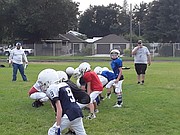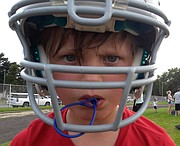LITTLE BIG MEN
Youth football enrollment up even as COVID-19 worries many
The gaggle of young kids formed a rough line at Person Field in Coeur d’Alene Monday evening, their jerseys — some generic, some displaying the boys’ favorite NFL players, all of them grass-stained — clinging to their shoulder pads.
“Down,” the young quarterback called out as he scanned the coverage of the 11 players playing defense, “set, hike!”
The pass play to his wide receiver — a 10-yard gain down the left side a few yards from the end zone — was one of the last plays of the Huskies’ practice that day, the fourth practice so far this season. The temperature had already cooled from its 98-degree high earlier that afternoon. The 8- and 9-year-olds had worked up a sweat, but their smiles said they were ready for more.
“Surprisingly, they seem like they’re in pretty good shape for that age group,” Huskies coach Cody Broyles — the Athol volunteer entering his fourth year of coaching — said after practice. “I expected to see a lot worse when I first got here.”
Broyles expected worse, he said, because of the COVID-19 pandemic that has stretched into its fifth month since striking Idaho in March. “Stay-home order,” “school shutdown” and “self-quarantine” have become as much a part of the young players’ lexicon as “screen pass,” “fly route” and “strong-side blitz.”
“(The kids) seem pretty aware of it,” Broyles noted. “They seem like they’re ready to come back.”
The Huskies are by no means alone. The 30 or so players — comprised mostly of kids getting their first taste of tackle football — make up a fraction of the nearly 400 participants in this year’s league.
“I thought we were going to see a drop in registrations this year,” said Paul Maland, one of the board members behind Coeur d’Alene Jr. Tackle Football. “Instead, we’re seeing about 10 percent growth across the board.”
That growth, Maland said, stems from something engraved into Americana: The late-summer ritual of what has become the country’s most popular sport.
“There’s a tremendous hunger for football,” he said. “It doesn’t quite feel like August without it. The other (North Idaho) leagues are all in the same mindset: Let’s press forward. Let’s try to have a normal season. That season might change in an instant, depending on how COVID-19 goes, but as of right now, football is rolling full speed.”
While the ritual has returned, football practices don’t look the same. Coaches wipe down footballs and equipment. The kids were all sent home with waivers for their parents to sign, indemnifying the league from COVID-related illnesses. And while parents still watch practice with nail-biting anticipation over their young ones getting the business ends of their first tackles, they cheer on their kids in clumps well beyond the 6-foot minimum distancing requirements.
“For us, we want the kids and their parents to uphold to the Panhandle Health social guidelines when they’re off the field,” Broyles said. “On the field, we’re trying to keep them as separated as possible, but the main thing is, off the field they’re maintaining Panhandle Health guidelines.”
The Centers for Disease Control segregates trainings and other interactions by risk assessment. The lowest-risk activities include skill-building drills or conditioning at home, alone or with family. Team-based practices, according to the CDC, are a slightly higher risk, followed by scrimmages, then full games within the same local geographic area. The highest risk is associated with full games between teams from different regions.
The recommendations include limiting participation to in-team scrimmages or team-only practices if social distancing can’t be followed.
But in football, there is no social distancing. Cornerbacks jockey for position with receivers. Linebackers stuff running backs. Quarterbacks get sacked. Linemen block linemen.
COVID-19 is diametrically opposed to football, but that hasn’t stopped kids or parents from coming to practices. It’s a conundrum Coeur d’Alene mother Caitlin Hazard weighed carefully before allowing her 8-year-old, Austin, to play.
“Yes, I am concerned,” Hazard said from the sideline at Person Field. “But I feel like, with everything that’s happened this year, he needs football to have some normalcy. That, and he has been asking for several years when he could play tackle (football). His heart would be broken if he couldn’t play this year.”
After the final whistle blew and Broyles debriefed the day’s practice with the team, the Huskies broke for the evening, and Austin joined his family. COVID-19 wasn’t on his mind. He was still digesting his coaches’ instructions to develop his skills before his first game Aug. 26. He hasn’t been assigned a position yet, but he’s hoping to be a wide receiver.
“I’m good at running, but I’m also a really good catcher,” Austin said.
“We’re proceeding with caution,” Maland said, “but you have to understand: These kids are coming in contact with one another. Whether it be grocery shopping, a family picnic or football, these kids are being in contact with one another …
“If anything, I think football teaches an overall discipline. Whether it comes from exposure from a teammate, I think it’s a way for kids to think a little bit bigger than themselves.”





